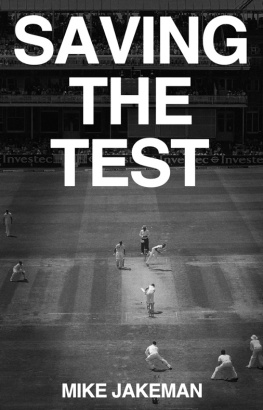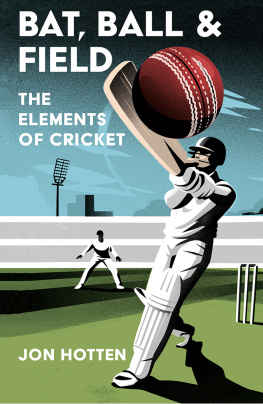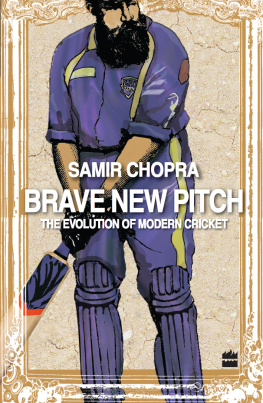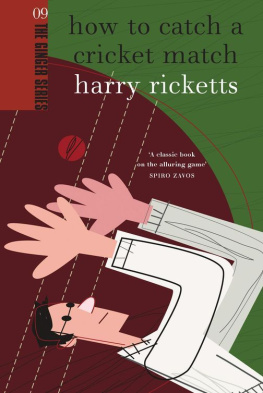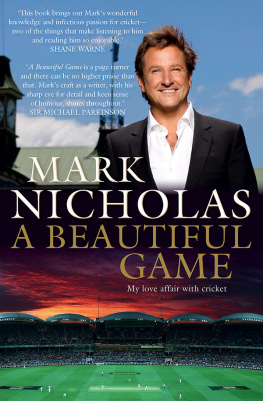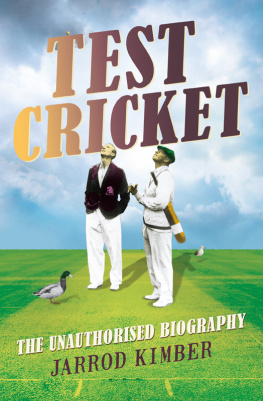

Saving The Test

by Mike Jakeman

www.ockleybooks.co.uk
Published by Ockley Books Ltd
First published 2013
All text copyright of the author
Cover image copyright held by Colorsport
The moral right of Mike Jakeman to be identified as the author of this work has been asserted
All rights reserved. No part of this book may be reproduced in any form without prior permission in writing from the author and publisher Ockley Books.
ISBN 978-1-783012442
Front Cover designed by Michael Atkinson
Layout & design by Michael Kinlan



About The Author
Mike Jakeman is a writer and editor with the Economist Group, where he spends his time thinking about Asia. He plays Sunday cricket, where he bowls like Paul Collingwood and bats like Chris Martin. He lives in London. This is his first book.

For Ken
Contents



Saving The Test
Foreword

by Jon Hotten

No-one forgets their first day of Test match cricket. I can even remember the date: Friday the 13th of August 1976, the summer that an endless heat-wave turned a green nation brown and had people queuing at standpipes in the streets. It was at Kennington Oval, the second morning of the Fifth Test between England and West Indies. There was a great sense of ritual to the day: lining up to click through the turnstile, buying a scorecard and a seat cushion, waiting for the five-minute bell to ring and the umpires to come down the pavilion steps, watching the fielding side walk out and then the batsmen, and hearing for the first time the strange silence made by many thousands of people saying nothing as the bowler runs in for the opening ball of the day...
To a kid like me it was huge and vivid, almost overpowering. Everything was bigger and faster and further, from the vastness of the outfield to the speed of the ball and how it was bowled, hit and thrown, and then the crowd, packed shoulder-to-shoulder on narrow wooden benches (hence the seat cushions50p for the day and worth every penny) a powerful force in its own right.
Out in the middle was IVA Richards, 200 not out overnight and in the mood for more, getting ever closer to one of the great and apparently unapproachable records of the game: Garry Sobers 365 not out, made against Pakistan almost 20 years before. Richards didnt just stroke the ball to boundary in the way it seemed on television. The movement that looked so languid when mediated by the cameras had a heft and a snap that could only be appreciated in the flesh. The ball rang from his bat with a sound I had never heard before, a bright crack with an echo of its own.
Richards got 291, bowled by Tony Greig just when it seemed that he might go past Sobers mark. It was his final innings of 1976, a year in which he had made 1,710 Test runsa record that would stand for another 30 years. Towards the end of the day, Clive Lloyd declared and Michael Holding came out and bowled at Englands openers, Bob Woolmer and Dennis Amiss. He ran in from somewhere near the boundary at the speed of a 400-metre sprinter, the ball an indistinct fuzz as it flew from his hand.
That game was Test match number 781. As I write, the Ashes series is about to begin, and the first of those will be Test number 2090. There have been almost twice as many Test matches since 1976 as there were before it. That day, though, remains indelibly in my senses. It exists there as well as on paper and in the archives. That is the essence of Test cricket.
It is hard to think of a game that sits at greater odds with the speed of the times it is played in. It was created in an era of leisure, its durations designed to fill tours when men crossed the world by boat. It is almost entirely anachronistic and yet its rhythms, which are symphonic, still exert their deep pull. When Test cricket is good, it is unmatchably good, its inherent tensions ratcheted up by the days used in their creation. Many of the greatest Test matches of them all have been played in the last couple of decades.
The questions over its future have been asked almost since it started, but they have been answered so far by its constancy. That alone cannot make us complacent about its ability to survive. Nothing lasts forever, and Test cricket is subject to external, societal forces of commerce, time, and multimedia. As much as it is loved in some competing nations, others can be ambivalent to it. For every sold-out Ashes series, there is some dubious exercise in Dubai or Sharjah or at an empty Caribbean outpost constructed for a long-forgotten World Cup.
Test matches have co-existed peacefully with one-day internationals (ODIs) since 1971. Indeed, it is the poor old ODI that is looking more and more like a busted flush, its format exhausted by players who know it too well. The rise of Twenty20 cricketthe short forms heightened and logical conclusionhas not been as harmonious.
Whether the five-day game can withstand these forces are the questions that Mike Jakeman has set out to answer in this challenging and very necessary book. To me, the very fact that the book exists states the case for Test cricket: that someone would devote the time and energy and skill is still more evidence of what it does to you. Yet there are some deep enquiries here, and the answers are not always in view. It is recommended reading, and if you have picked it up and come this far, you probably already know why.
Jon Hotten, July 2013
Jon is the author of Muscle and The Years Of The Locust.
He writes the popular cricket blog, The Old Batsman.
Next page
